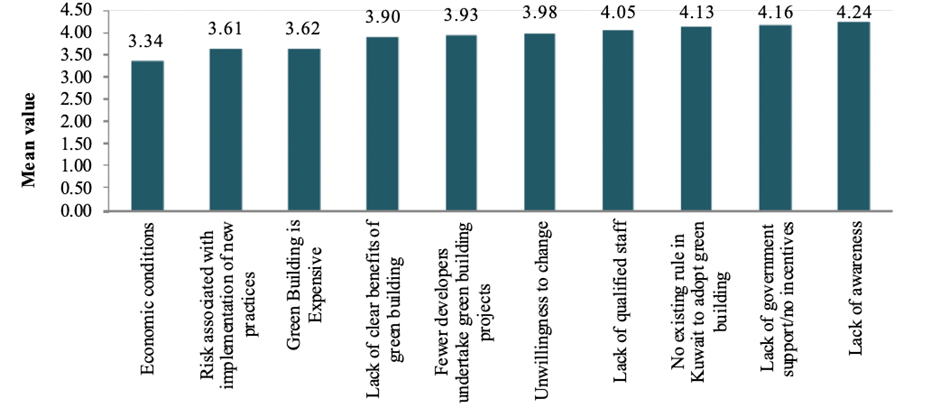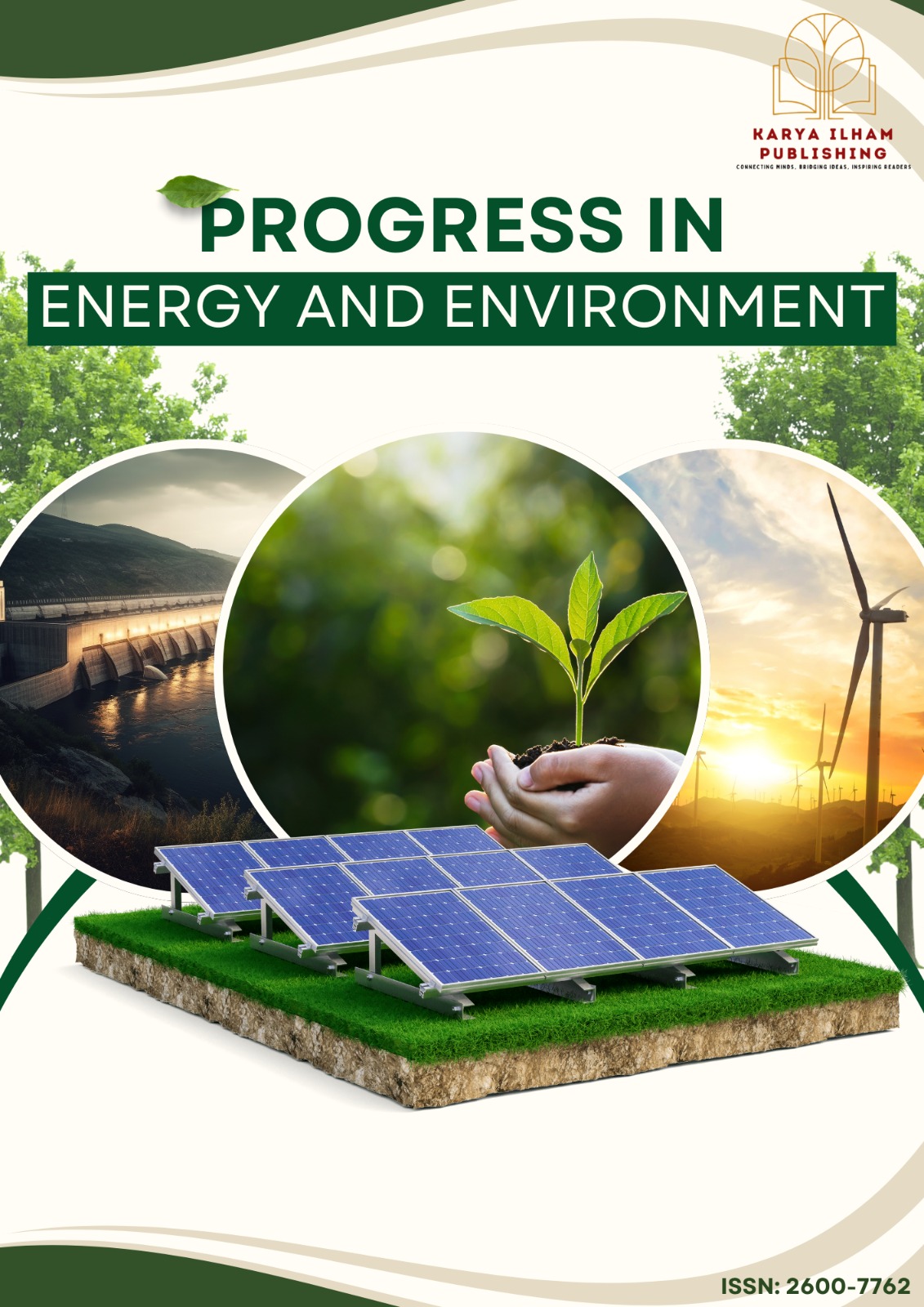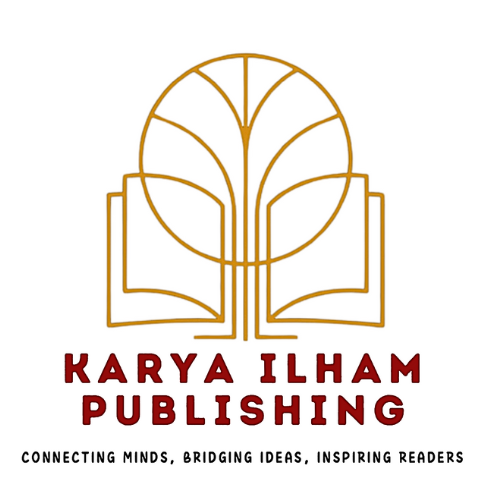Critical Pathways for Advancing Sustainable and Environmentally Responsible Design in Commercial Building Projects
Keywords:
Sustainable Buildings (SB), Advancement, Green Buildings (GB), Construction, Priority Criteria, Environmental FriendlyAbstract
Nowadays, one of the biggest worldwide problems is resource depletion and environmental damage. The construction industry has taken leading roles in energy conservation and emission reduction since buildings are the primary habitat for humans and are major sources of energy consumption and pollution emissions. In recent years, the concept of sustainability has drawn the interest of numerous disciplines. Green building (GB) is the fundamental element of sustainable development as it defines the style of buildings designed and constructed by environmentally friendly principles. In this regard, this study draws attention to evaluating and addressing the most important topics: the priority criteria for advancing GB for commercial buildings. Therefore, to enhance and promote the development of green buildings, it is crucial to comprehend the factors that determine the successful application of green features to ensure that the obstacles during the construction process are overcome. The research identifies key criteria such as energy efficiency, material selection, water conservation, and indoor environmental quality through comprehensive literature reviews, surveys, and case studies. By analysing stakeholder perspectives, including architects, builders, and tenants, this research highlights the most impactful criteria for promoting green building initiatives. The findings offer valuable insights for policymakers, developers, and industry professionals, ultimately contributing to a more sustainable built environment. This study highlights the elements driving the acceptance of green buildings and barriers to their execution, providing valuable insights for stakeholders engaged in the ongoing discourse concerning green building development. Consequently, interested parties will gain better understanding of the factors affecting the priority criteria for the progression of green buildings in the commercial buildings.
References
[1] C.C. Bungau, T. Bungau, I.F. Prada, and M.F. Prada, Green Buildings as a Necessity for Sustainable Environment Development: Dilemmas and Challenges. Sustainability 14 (2022) 13121. https://doi.org/10.3390/su142013121.
[2] K. Ullah, I. Lill, and E. Witt, An overview of BIM Adoption in the Construction Industry: Benefits and Barriers, in: Emerald Reach Proceedings Series, 2019: pp. 297–303. https://doi.org/10.1108/s2516-285320190000002052.
[3] O. Awadh, Sustainability and Green Building Rating Systems: LEED, BREEAM, GSAS and Estidama Critical Analysis. Journal of Building Engineering 11 (2017) 25–29. https://doi.org/10.1016/j.jobe.2017.03.010.
[4] Y.A. Horr, M. Arif, M. Katafygiotou, A. Mazroei, A. Kaushik, and E. Elsarrag, Impact of Indoor Environmental Quality on Occupant Well-Being and Comfort: A Review of the Literature. International Journal of Sustainable Built Environment 5 (2016) 1–11. https://doi.org/10.1016/j.ijsbe.2016.03.006.
[5] N. Jaffar, N.I.N. Affendi, I.M. Ali, N. Ishak, and A.S. Jaafar, Barriers of Green Building Technology Adoption in Malaysia: Contractors’ Perspective. International Journal of Academic Research in Business and Social Sciences 12 (2022). https://doi.org/10.6007/ijarbss/v12-i8/14490.
[6] S. Evjen, G. Gunnerud, O. Lædre, R. Søfting, and J. Lohne, Sub-Contractors’ Perception of Contracting: the Case of Crime, in: Emerald Reach Proceedings Series, 2019: pp. 59–67. https://doi.org/10.1108/s2516-285320190000002059.
[7] N. Frederiksen, L. Fredslund, and S.C. Gottlieb, The Hybridity of Strategic Partnerships and Construction Supply Chain Management, in: Emerald Reach Proceedings Series, 2019: pp. 77–83. https://doi.org/10.1108/s2516-285320190000002029.
[8] J.S. Khan, R. Zakaria, S.M. Shamsudin, N.I.A. Abidin, S.R. Sahamir, D.N. Abbas, and E. Aminudin, Evolution to Emergence of Green Buildings: A Review, Administrative Sciences 9 (2019) 6. https://doi.org/10.3390/admsci9010006.
[9] H. Jaradat, O.A.M. Alshboul, I.M. Obeidat, and M.K. Zoubi, Green Building, Carbon Emission, and Environmental Sustainability of Construction Industry in Jordan: Awareness, Actions and Barriers. Ain Shams Engineering Journal 15 (2023) 102441. https://doi.org/10.1016/j.asej.2023.102441.
[10] Y. Mo, D. Zhao, A. McCoy, J. Du, and P. Agee, Latent Relationship between Construction Cost and Energy Efficiency in Multifamily Green Buildings. Computing in Civil Engineering (2017). https://doi.org/10.1061/9780784480847.034.
[11] L.N. Dwaikat, and K.N. Ali, Green Buildings Cost Premium: A Review of Empirical Evidence, Energy and Buildings 110 (2015) 396–403. https://doi.org/10.1016/j.enbuild.2015.11.021.
[12] A. Yeganeh, A.P. McCoy, G. Reichard, T. Schenk, and S. Hankey, Green Building and Policy Innovation in the US Low-Income Housing Tax Credit Programme. Building Research & Information 49 (2020) 543–560. https://doi.org/10.1080/09613218.2020.1842165.
[13] C. Bruegge, C. Carrión-Flores, and J.C. Pope, Does the Housing Market Value Energy Efficient Homes? Evidence from the Energy Star Program. Regional Science and Urban Economics 57 (2015) 63–76. https://doi.org/10.1016/j.regsciurbeco.2015.12.001.
[14] C.J. Kibert, Sustainable Construction: Green Building Design and Delivery, 2005. http://ci.nii.ac.jp/ncid/BA84930188.
[15] S. AlSanad, Awareness, Drivers, Actions, and Barriers of Sustainable Construction in Kuwait. Procedia Engineering 118 (2015) 969–983. https://doi.org/10.1016/j.proeng.2015.08.538.
[16] N. Winston, Regeneration for Sustainable Communities? Barriers to Implementing Sustainable Housing in Urban Areas. Sustainable Development 18 (2009) 319–330. https://doi.org/10.1002/sd.399.
[17] A.M. Maglad, M.A.O. Mydin, S.D. Datta, and B.A. Tayeh, Assessing the Mechanical, Durability, Thermal and Microstructural Properties of Sea Shell Ash based Lightweight Foamed Concrete. Construction and Building Materials 402 (2023) 133018. Https://doi.org/10.1016/j.conbuildmat.2023.133018.
[18] M.A. Tambichik, A.A.A. Samad, N. Mohamad, A.Z.M. Ali, M.A.O. Mydin, M.Z.M. Bosro, and M.A. Iman, Effect of Combining Palm Oil Fuel Ash (POFA) and Rice Husk Ash (RHA) as Partial Cement Replacement to the Compressive Strength of Concrete. International Journal of Integrated Engineering 10 (2018). https://doi.org/10.30880/ijie.2018.10.08.004.
[19] S. Ganesan, M.A.O. Mydin, N.Md. Sani, and A.I.C. Ani, Performance of Polymer Modified Mortar with Different Dosage of Polymeric Modifier. MATEC Web of Conferences 15 (2014) 01039. https://doi.org/10.1051/matecconf/20141501039.
[20] M.A.O. Mydin, N.S. Sahidun, M.Y.M. Yusof, and N.M. Noordin, Compressive, Flexural and Splitting Tensile Strengths of Lightweight Foamed Concrete with Inclusion of Steel Fibre. Jurnal Teknologi 75 (2015). https://doi.org/10.11113/jt.v75.4962.
[21] E. Serri, M.A. Othuman Mydin, and M.Z. Suleiman, The Influence of Mix Design on Mechanical Properties of Oil Palm Shell Lightweight Concrete. Journal of Materials and Environmental Science 6 (2015) 607–612.
[22] M.A.O. Mydin, Drywall Thermal Properties Exposed to High Temperatures and Fire Condition. Jurnal Teknologi 62 (2013). https://doi.org/10.11113/jt.v62.1369.
[23] N.S.S. Suhaili, N.M.A.O. Mydin, and N.H. Awang, Influence of Mesocarp Fibre Inclusion on Thermal Properties of Foamed Concrete. Journal of Advanced Research in Fluid Mechanics and Thermal Sciences 87 (2021) 1–11. https://doi.org/10.37934/arfmts.87.1.111.
[24] M.A.O. Mydin, M.F.M. Shajahan, S. Ganesan, and N.Md. Sani, Laboratory Investigation on Compressive Strength and Micro-structural Features of Foamed Concrete with Addition of Wood Ash and Silica Fume as a Cement Replacement. MATEC Web of Conferences 17 (2014) 01004. https://doi.org/10.1051/matecconf/20141701004.
[25] M.A.O. Mydin, M. Musa, and A.N.A. Ghani, Fiber Glass Strip Laminates Strengthened Lightweight Foamed Concrete: Performance Index, Failure Modes and Microscopy Analysis. AIP Conference Proceedings 2016 (2018) 020111. https://doi.org/10.1063/1.5055513.
[26] M.A.O. Mydin, N.Md. Noordin, N. Utaberta, M.Y.M. Yunos, and S. Segeranazan, Physical Properties OF Foamed Concrete Incorporating Coconut Fibre. Jurnal Teknologi 78 (2016). https://doi.org/10.11113/jt.v78.8250.
[27] M.A.O. Mydin, Modeling of Transient Heat Transfer in Foamed Concrete Slab. Directory of Open Access Journals (2013). https://doaj.org/article/494752dfe026401da3f4f0fc83a60325.
[28] M.A.O. Mydin, Thin-walled Steel Enclosed Lightweight Foamcrete: A Novel Approach to Fabricate Sandwich Composite. Australian Journal of Basic and Applied Sciences, 5 (2011) 1727–1733.
[29] M.A.O. Mydin, N.M. Sani, and A.F. Phius, Investigation of Industrialised Building System Performance in Comparison to Conventional Construction Method. MATEC Web of Conferences 10 (2014) 04001. https://doi.org/10.1051/matecconf/20141004001.
[30] M.A.O. Mydin, P. Jagadesh, A. Bahrami, A. Dulaimi, Y.O. Özkılıç, M.M.A.B. Abdullah, and R.P. Jaya, Use of Calcium Carbonate Nanoparticles in Production of Nano-Engineered Foamed Concrete. Journal of Materials Research and Technology 26 (2023) 4405–4422. https://doi.org/10.1016/j.jmrt.2023.08.106.
[31] M.A.O. Mydin, N.M. Zamzani, and A.N.A. Ghani, Effect of Alkali-Activated Sodium Hydroxide Treatment of Coconut Fiber on Mechanical Properties of Lightweight Foamed Concrete. AIP Conference Proceedings (2018). https://doi.org/10.1063/1.5055510.
[32] A.M.J. Esruq-Labin, A.I. Che-Ani, N.M. Tawil, M.N.M. Nawi, and M.A.O. Mydin, Criteria for Affordable Housing Performance Measurement: a review. E3S Web of Conferences 3 (2014) 01003. https://doi.org/10.1051/e3sconf/20140301003.
[33] M.A.O. Mydin, J.C. Khor, and N.Md. Sani, Approaches to Construction Waste Management in Malaysia. MATEC Web of Conferences 17 (2014) 01014. Https://doi.org/10.1051/matecconf/20141701014.
[34] M. Alyami, M.A.O. Mydin, A.M. Zeyad, S.S. Majeed, and B.A. Tayeh, Influence of Wastepaper Sludge ash as Partial Cement Replacement on the Properties of Lightweight Foamed Concrete. Journal of Building Engineering 79 (2023) 107893. https://doi.org/10.1016/j.jobe.2023.107893.
[35] M.A.O. Mydin, N.A. Rozlan, N.Md. Sani, and S. Ganesan, Analysis of Micro-Morphology, Thermal Conductivity, Thermal Diffusivity and Specific Heat Capacity of Coconut Fibre Reinforced Foamed Concrete. MATEC Web of Conferences 17 (2014) 01020. https://doi.org/10.1051/matecconf/20141701020.
[36] A.M. Maglad, M.A.O. Mydin, S.S. Majeed, B.A. Tayeh, and S.A. Mostafa, Development of Eco-Friendly Foamed Concrete with Waste Glass Sheet Powder for Mechanical, Thermal, and Durability Properties Enhancement. Journal of Building Engineering 80 (2023) 107974. https://doi.org/10.1016/j.jobe.2023.107974.
[37] M.A.O. Mydin, and N.M. Zamzani, Coconut Fiber Strengthen High Performance Concrete: Young’s Modulus, Ultrasonic Pulse Velocity and Ductility Properties. International Journal of Engineering & Technology 7 (2018) 284. https://doi.org/10.14419/ijet.v7i2.23.11933.
[38] A.M. Maglad, M.A.O. Mydin, R.C. Kaze, I.S. Abbood, and B.A. Tayeh, Synergistic Effect of Waste Gypsum Plasterboard and Fly Ash as Partial Cement Replacement on Fresh-State, Microstructural, Mechanical and Transport Properties of Foamed Concrete. Construction and Building Materials 463 (2025) 140079. https://doi.org/10.1016/j.conbuildmat.2025.140079.
[39] M. Alharthai, M.A.O. Mydin, R.C. Kaze, S.S. Majeed, and B.A. Tayeh, Properties of Ultra Lightweight Foamed Concrete Utilizing Agro Waste Ashes as an Alkaline Activated Material. Journal of Building Engineering 90 (2024) 109347. https://doi.org/10.1016/j.jobe.2024.109347.
[40] M.A.O. Mydin, M.M.A.B. Abdullah, N.H. Sor, R. Omar, A. Dulaimi, P.O. Awoyera, F. Althoey, and A.F. Deifalla, Thermal Conductivity, Microstructure and Hardened Characteristics of Foamed Concrete Composite Reinforced with Raffia Fiber. Journal of Materials Research and Technology 26 (2023) 850–864. https://doi.org/10.1016/j.jmrt.2023.07.225.
[41] M.A.O. Mydin, M.N.M. Nawi, O. Mohamed, and M.W. Sari, Mechanical Properties of Lightweight Foamed Concrete Modified with Magnetite (Fe3O4) Nanoparticles. Materials 15 (2022) 5911. https://doi.org/10.3390/ma15175911.
[42] M. Musa, M. A. O. Mydin, and A.N.A. Ghani, Influence of Oil Palm Empty Fruit Bunch (EFB) Fibre on Drying Shrinkage in Restrained Lightweight Foamed Mortar. International Journal of Innovative Technology and Exploring Engineering 8 (2019) 4533–4538. https://doi.org/10.35940/ijitee.j1080.0881019.
[43] M.A.O. Mydin, S. Ganesan, M.Y.M. Yunos, N. Utaberta, and N.A. Ismail, Structural Behaviour of Coir Fibre-Reinforced Foamed Concrete Wall Panel System. Jurnal Teknologi 78 (2016). https://doi.org/10.11113/jt.v78.8276.
[44] M.A.O. Mydin, N.A. Othman, and N.Md. Sani, A Prospective Study on Building Quality: Relationship between Workmanship Quality and Common Building Defects of Low-cost Construction Projects. MATEC Web of Conferences 17 (2014) 01001. https://doi.org/10.1051/matecconf/20141701001.
[45] S.S. Majeed, M.A.O. Mydin, A. Bahrami, A. Dulaimi, Y.O. Özkılıç, R. Omar, and P. Jagadesh, Development of Ultra-Lightweight Foamed Concrete Modified with Silicon Dioxide (SiO2) Nanoparticles: Appraisal of Transport, Mechanical, Thermal, and Microstructural Properties. Journal of Materials Research and Technology 30 (2024) 3308–3327. https://doi.org/10.1016/j.jmrt.2024.01.282.
[46] M.A.O. Mydin, N.H. Sor, F. Althoey, Y.O. Özkılıç, M.M.A.B. Abdullah, H.F. Isleem, A.F. Deifalla, and T.A. Tawfik, Performance of Lightweight Foamed Concrete Partially Replacing Cement with Industrial and Agricultural Wastes: Microstructure Characteristics, Thermal Conductivity, and Hardened Properties. Ain Shams Engineering Journal 14 (2023) 102546. https://doi.org/10.1016/j.asej.2023.102546.
[47] M.A.O. Mydin, M.N.M. Nawi, R. Omar, M.A. Khadimallah, I.M. Ali, and R. Deraman, The USE of Inorganic Ferrous–Ferric Oxide Nanoparticles to Improve Fresh and Durability Properties of foamed Concrete. Chemosphere 317 (2023) 137661. https://doi.org/10.1016/j.chemosphere.2022.137661.
[48] T.S. Jing, M.A.O. Mydin, and N. Utaberta, Appraisal of Moisture Problem of Inheritance Building Envelope Assemblies via Visible and Infrared Thermography Methods. Jurnal Teknologi 75 (2015). https://doi.org/10.11113/jt.v75.4951.
[49] M. A. O. Mydin, Effect of Silica Fume and Wood Ash Additions on Flexural and Splitting Tensile Strength of Lightweight Foamed Concrete. Jurnal Teknologi 74 (2015). https://doi.org/10.11113/jt.v74.3653.
[50] M.A.O. Mydin, M.N.M. Nawi, R.A. Odeh, and A.A. Salameh, Durability Properties of Lightweight Foamed Concrete Reinforced with Lignocellulosic Fibers. Materials 15 (2022) 4259. Https://doi.org/10.3390/ma15124259.
[51] A.M. Serudin, M.A.M. Othuman, and A.N.A. Ghani, Effect of Lightweight Foamed Concrete Confinement with Woven Fiberglass Mesh on its Drying Shrinkage, Revista De Ingeniería De ConstruccióN 36 (2021) 21–28. https://doi.org/10.4067/s0718-5073202100010002.
[52] A.M. Serudin, M.A.O. Mydin, and A.N.A. Ghani, Influence of Fibreglass Mesh on Physical Properties of Lightweight Foamcrete. IIUM Engineering Journal 22 (2021) 23–34. https://doi.org/10.31436/iiumej.v22i1.1446.
[53] M.A.O. Mydin, The Effect of Raw Mesocarp Fibre Inclusion on the Durability Properties of Lightweight Foamed Concrete. ASEAN Journal on Science and Technology for Development 38 (2021). https://doi.org/10.29037/ajstd.685.
[54] M.A.O. Mydin, N. Sarpin, R.M. Zainol, R. Odeh, and M.N.M. Nawi, The Impact of Climatological Factors on the Multifaceted and Multisystemic Deficiencies of Building Anatomy. Journal of Advanced Research in Applied Sciences and Engineering Technology 50 (2024) 308–329. https://doi.org/10.37934/araset.50.1.308329.
[55] A. Dulaimi, Q.S. Banyhussan, J. Abdulrazzaq, M.A.O. Mydin, A. Al-Bdairi, and R.R.A. Almuhanna, Effect of Water Content and Degree of Compaction of Clay Subgrade Soil on the Interface Shear Strength using Geogrid. Journal of Advanced Research in Applied Sciences and Engineering Technology (2024) 262–280. https://doi.org/10.37934/araset.52.2.262280.
[56] M.A.O. Mydin, A.I.C. Ani, A. Dulaimi, M.N.M. Nawi, and R. Omar, Assessing the Effects of Insect Attacks on Buildings and Practical Corrective Measures. Journal of Advanced Research in Applied Sciences and Engineering Technology 50 (2024) 1–17. https://doi.org/10.37934/araset.50.1.117.
[57] N.J. Japok, N.M.A.O. Mydin, and N.R. Omar, Identification of Structural and Non-Structural Defects of Load-Bearing Wall Systems in Low Rise Buildings. Journal of Advanced Research in Applied Mechanics 120 (2024) 171–188. https://doi.org/10.37934/aram.120.1.171188.
[58] M.A.O. Mydin, N.H. Ja’afar, N. Norazman, M.A. Zaidi, and M.N.M. Nawi, Appraisal of the aetiology and Pathology of Soil Settlement-Related Building Defects and Failures. Journal of Advanced Research in Applied Sciences and Engineering Technology 50 (2024) 286–307. https://doi.org/10.37934/araset.50.1.286307.
[59] P. Arokiasamy, M.M.A.B. Abdullah, E. Arifi, N.H. Jamil, M.A.O. Mydin, S.Z.A. Rahim, A.V. Sandu, and S. Ishak, Sustainable Geopolymer Adsorbents Utilizing Silica Fume as a Partial Replacement for Metakaolin in the Removal of Copper Ion from Synthesized Copper Solution. Case Studies in Construction Materials (2024) e04142. https://doi.org/10.1016/j.cscm.2024.e04142.
[60] A.M. Maglad, M.A.O. Mydin, R.C. Kaze, I.S. Abbood, and B.A. Tayeh, Synergistic Effect of Waste Gypsum Plasterboard and Fly Ash as Partial Cement Replacement on Fresh-State, Microstructural, Mechanical and Transport Properties of Foamed Concrete. Construction and Building Materials 463 (2025) 140079. https://doi.org/10.1016/j.conbuildmat.2025.140079.

Downloads
Published
Issue
Section
License
Copyright (c) 2025 Progress in Energy and Environment

This work is licensed under a Creative Commons Attribution-NonCommercial 4.0 International License.











